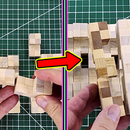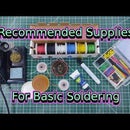Introduction: Recommended Tools for Basic Soldering
In this Instructable I'll be going over some of the basic tools that I would recommend having if you're going to be doing much soldering. These are tools that you can solder without, but they will be helpful to have. If you haven't seen my Required Tools and Supplies Instructable yet, I recommend checking that out, because I won't be discussing those items in this Instructable.
If you would like to watch a video of this, you can check that out here: https://youtu.be/L7KSPx8J3gs
Step 1: Helping Hands
Helping Hands is basically anything that will hold your wires or circuit board for you while you are trying to solder. There are many options for these. Some have a magnifying glass, while some don't. Some just have two hands, and some will have several. There are even some soldering stations that have helping hands built right into them. I don't have one of those myself, but I wish I did. Keep in mind that the clamps used for the hands have teeth that may dig into the wire insulation. Some of them will have protective pads to prevent that. If you have a Helping Hands that doesn't have those protective pads, like mine doesn't, I'll show you in my Recommended Supplies Instructable how to make your own.
Here are links for some options:
Step 2: Soldering Iron Tips
Some soldering irons have tips that can be replaced, while others have a single, permanent tip. Replaceable tips can be handy for several reasons. Obviously, if your tip gets damaged then you don't need to replace the whole soldering iron. A more common need for replaceable tips is that they have different use cases. Tips come in different shapes and sizes, each with their own purpose. When first learning how to solder, a general rule of thumb that you can follow is similar to what I mentioned about different solder thicknesses in my Required Tools And Supplies Instructable. For thicker wires and bigger parts, a bigger tip is better. For thinner wires and smaller parts, a smaller tip is better.
Here are links for some options:
Step 3: Wire Cutters
Not all solder tasks need wires to be cut, but it is common. You can use regular wire cutters if that's what you have, but if you're trimming the excess leads from a soldered through-hole component, it's recommended to have a pair of flush cut wire cutters. Regular wire cutters are curved, so when you trim the leads with those, there is a bit of the lead left sticking out. This won't always be an issue, but sometimes it may. Flush cut wire cutters are flat on the cutting side, so they will allow you to trim the lead even shorter.
Here are links for some options:
Step 4: Wire Strippers
If you're soldering with wires, there's a good chance that you'll need to remove some of the insulation at some point. You could use a knife, a razor blade, or sometimes even your wire cutters, but it's better to use wire strippers. If you nick the wire when trying to remove the insulation, it will be more likely to break where it was nicked. Just make sure you use the proper setting for the gauge of wire you're using. Some wire strippers are auto adjusting, but even those will have a wire size range that they are designed for.
Here are links for some options:
Step 5: Desoldering Pump
Sometimes you'll need to remove a part that's soldered into place, and a desoldering pump can be helpful with removing the solder. Sometimes they are also be called a solder sucker, because that's exactly what they do. A lot of them are designed to be used with your soldering iron, but there are also some with a heating element built in so that you can melt and remove the solder with one device. Most of them have a mechanical pump, but there are some more expensive ones with an electric, vacuum pump. When desoldering, I also recommend having some desoldering wick handy, but I'll discuss that in my Recommended Supplies Instructable. I already have an Instructable where I show you how to use both of these, so make sure you check out my Desoldering Instructable.
Here are links for some options:
Step 6: That's It!
These are some of the main tools that I recommend for basic soldering, but if I missed any that you would also recommend, please leave a comment and let us know what it is. And make sure you watch for my Recommended Supplies for Basic Soldering Instructable. Also let me know if you would like me to make individual Instructable about each of these items where I go into more detail. Thank you for checking out this Instructable!

Participated in the
Anything Goes Contest







![Tim's Mechanical Spider Leg [LU9685-20CU]](https://content.instructables.com/FFB/5R4I/LVKZ6G6R/FFB5R4ILVKZ6G6R.png?auto=webp&crop=1.2%3A1&frame=1&width=306)





